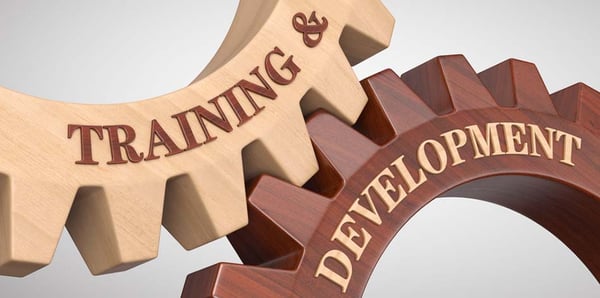
A Learning-Based Company Culture: Your Strategic Asset
By Carole Wehn
You may have heard expressions like “our people are our competitive advantage.” And it’s true – a motivated, talented workforce can be one of your strategic assets. Unlike products and processes that competitors can duplicate, your employees are uniquely your own. But how does that drive competitive advantage, and how can you nurture and maintain it?
You can hire the “right” people with highly developed skills and a strong work ethic. You can empower them in work teams and give them cutting-edge tools. But it’s how they come together in a supportive company culture that creates a strategic advantage. One component of such a culture is to provide an environment where learning and development thrive.
Providing a Learning Culture
A learning culture doesn’t have to offer a catalog of training courses. You don’t need an in-house learning and development team. And you don’t have to have a dedicated campus like the storied GE Crotonville leadership center.
Instead, a learning culture is one where employees at all levels are eager to get new skills and experiences. It’s an environment where:
- Learning and knowledge-sharing are enabled and encouraged
- Constructive feedback and meaningful recognition are shared
- What worked well and what didn’t are analyzed, and course corrections are implemented
- Employee development conversations frequently occur to ensure employees get the opportunities they seek
Beyond bolstering skillsets throughout the workforce, this focus on development also drives employee retention.
Linking Learning to Competitive Advantage
A learning culture not only helps retain employees but enables companies to keep pace with today’s rapid workplace change.
A McKinsey report report observes,
“The shift to a digital, knowledge-based economy means that a vibrant workforce is more important than ever: research suggests that a very significant percentage of market capitalization in public companies is based on intangible assets—skilled employees, exceptional leaders, and knowledge.
The most important way to engage employees is to provide them with opportunities to learn and develop new competencies. Research suggests that lifelong learning contributes to happiness. When highly engaged employees are challenged and given the skills to grow and develop within their chosen career path, they are more likely to be energized by new opportunities at work and satisfied with their current organization.”
Gallup does extensive research around employee engagement and satisfaction. They find,
“Organizations that have made a strategic investment in employee development report 11 percent greater profitability and are twice as likely to retain their employees.”
An engaged workforce leads to retention because employees enjoy their jobs. And retention results in lower recruitment costs, workforce continuity, and growth of institutional knowledge.
It Starts at The Top
Learning and development aren’t only for junior staffers. It needs to be embedded in your culture for employees at all levels. And it starts at the top.
In Culture by Design, author David J. Friedman includes leading by example as one of his eight steps in implementing culture. He notes:
“Whether it’s fair or not, our people are observing us every minute of every day, consciously and unconsciously, and they’re taking their cue from us about what really matters. We can talk all day long about delivering legendary service, but how we respond to a difficult customer issue will have more impact than anything we say.”
Accordingly, a learning culture starts with a leadership model. Leaders need to demonstrate that they don’t have all the answers but are motivated to learn.
Management expert John P. Kotter, in his book Leading Change, suggests five mental habits that support lifelong learning:
- Risk-taking – getting out of one’s comfort zone
- Humble self-reflection – an honest assessment of one’s prior successes and failures
- Solicitation of opinions – a relentless collection of ideas and information from others
- Careful listening
- Openness to new ideas.
Kotter says that lifelong learning requires humility. Leaders can’t be arrogant about their past achievements. Instead, they need to seek and accept feedback. They should reflect honestly on previous triumphs and disappointments. And they must acknowledge that the way they have done things in the past may not take the company to the next level.
Not for Top Leaders Only
Lifelong learning is essential for good leaders. However, learning and development should be available to all employees. It\’s not only for the senior management ranks or high-potential staffers.
MIT/Sloan Management surveyed the elements of culture that matter most to employees. About a third of respondents cited learning and development. The surveyed employees expressed interest in things like tuition reimbursement. Yet they also seek exposure to senior executives to learn what\’s on their minds. Learning opportunities were only slightly more important to surveyed white-collar than blue-collar employees.
Millennials are particularly focused on opportunities for learning and growth. Gallup found that it’s one of the top three keys to retaining workers in that age group. Yet only about a third of surveyed millennials said they recently learned something that will help them do their jobs better.
Accordingly, managers of younger workers need to be attuned to their team\’s needs for more training and development opportunities.
The Many Facets of Employee Learning & Development
Blogger Jocelyn Strange in Quantum Workplace defines employee development as,
“the process of working with your employees to develop, improve, and hone their existing skills and train them on new skills. Employee development aims to build a talent pool that supports the organization’s mission while creating highly engaged employees.”
The types of development that employees seek, she asserts, include:
- Online webinars and training
- Manager coaching and mentorship
- Classroom learning
- Peer coaching
- Cross-training, and
- Stretch assignments.
Online Training Opportunities
Bill Gates is an excellent example of a lifelong learner. Despite his career success, he is known for reading about fifty books a year on a wide variety of topics and genres. However, his quest for knowledge is not satisfied exclusively through books. He told CNBC,
“There’s never been a better time to be alive if you’re curious. When I wanted to learn something outside of school as a kid, cracking open my World Book encyclopedia was the best I could do. Today, all you have to do is go online.”
Online learning can range from massive open online courses (MOOCs) to small private online courses (SPOCs) to free courses offered by local libraries. In addition, you can learn new skills from YouTube videos and explore new concepts via TED talks. Current learning trends are short videos and podcasts, which employees can access at their convenience.
Coaching and Mentorship
Employee development is a critical component of a manager’s basic job description. Good managers ask employees how they would solve a problem and then provide feedback. They encourage employees’ growth by asking questions and offering support and guidance. They provide meaningful recognition. Importantly, they serve as coaches rather than giving orders and judging.
Much has been written about mentorship and whether mentor/mentee relationships should be assigned or allowed to develop organically. Whichever approach best serves your organization, encourage managers to take this responsibility seriously. Most employees want and need the guidance of those who have already climbed the corporate ladder. In particular, younger workers want to meet senior leaders and hear about their work experiences.
An important part of mentoring is not just relaying experience but getting to know employees. Ask mentees about their career aspirations, what they enjoy doing, and what they’d like to try. And mentors need to listen carefully to what experiences and education employees seek.
The Desire for Peer Coaching
A Harvard Business School article observes that when employees want to learn a new skill, more than half seek out a colleague. For example, they ask someone who can show them how to write a formula in Excel or can help them interpret their department’s budget report.
“Peer learning offers a way to support rapid, just-in-time learning, while strengthening the existing understanding your employees have about concepts,” author Steve Glaveski notes, “It could be as simple as establishing an online marketplace, or periodic peer learning workshops, to connect employees who are willing to teach specific skills with colleagues who want to acquire such skills.”
Sharing forums such as “lunch and learns” enable such knowledge transfer.
Benefit of Cross-Training
Historically, career advancement meant moving up the ranks in a narrow progression. But today’s career paths are non-linear and not limited to one functional area. Employees seek to gain broader skills and are open to lateral career moves. Cross-training provides new skills and experiences which may prepare employees for lateral transfers. It also equips them to participate in cross-functional teams and pitch in to cover job vacancies.
Stretch Your Employees
Stretch assignments give employees a chance to use their skills in new ways, such as participation in a product development team or a system implementation project. These assignments may be cross-functional and empower team members to serve as subject matter experts.
A stretch assignment could also be covering for a more senior person who is on extended leave. These opportunities let team members “show what they’re made of,” giving them job satisfaction and allowing management to see employees’ potential.
Implementing a Learning Culture
When Kraft and Heinz merged in 2015, they had an opportunity to create a new learning and development environment for employees. Four years later, they launched the #LearnLikeAnOwner Challenge to the entire company. They invited employees to help develop a culture of continuous learning, bold creativity, and intellectual curiosity.
Their value proposition for this initiative is:
- Seek out high-impact learning experiences.
- Commit to a regular learning practice, even if it’s just a few minutes a day.
- Encourage others to do the same. Contribute to a culture of learning.
While you may not have the resources or global workforce of Kraft Heinz, you too can put in place a culture of learning. Give your team low-cost but high-quality mentoring, peer coaching, and stretch assignments. Encourage the use of free internet-based educational resources. Recruit employees to recommend articles, videos, and podcasts to one another. Ask your team to commit to periodic learning. Most importantly, show them that you are a lifelong learner.
If you want to learn more about culture and how to change yours, David Friedman’s book Culture by Design is a great resource. Friedman outlines his eight-step approach to culture implementation, which includes identifying and reinforcing through ritual the behaviors you want to see in your organization. Download a free two-chapter excerpt to learn more.
For those who would like help, CultureWise assists in implementing the Culture by Design approach. There are both standard and customized options. Connect with one of our team for more information.
Find more resources on our website at culturewise.com, and follow the latest developments in corporate culture by subscribing to our weekly newsletter, Culture Matters.



